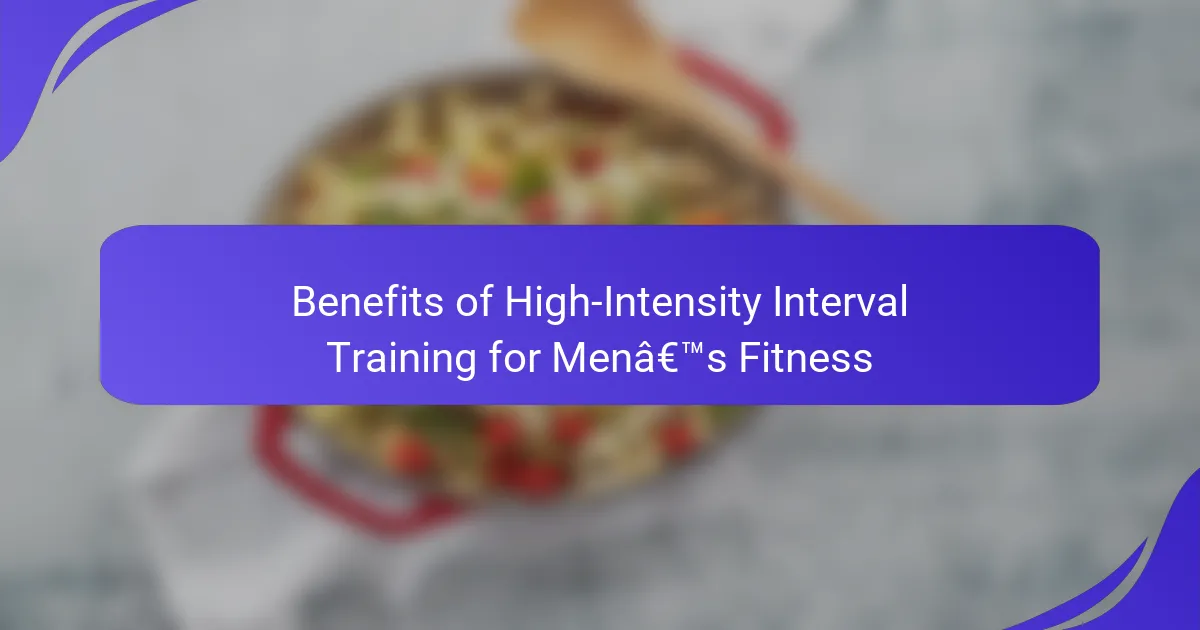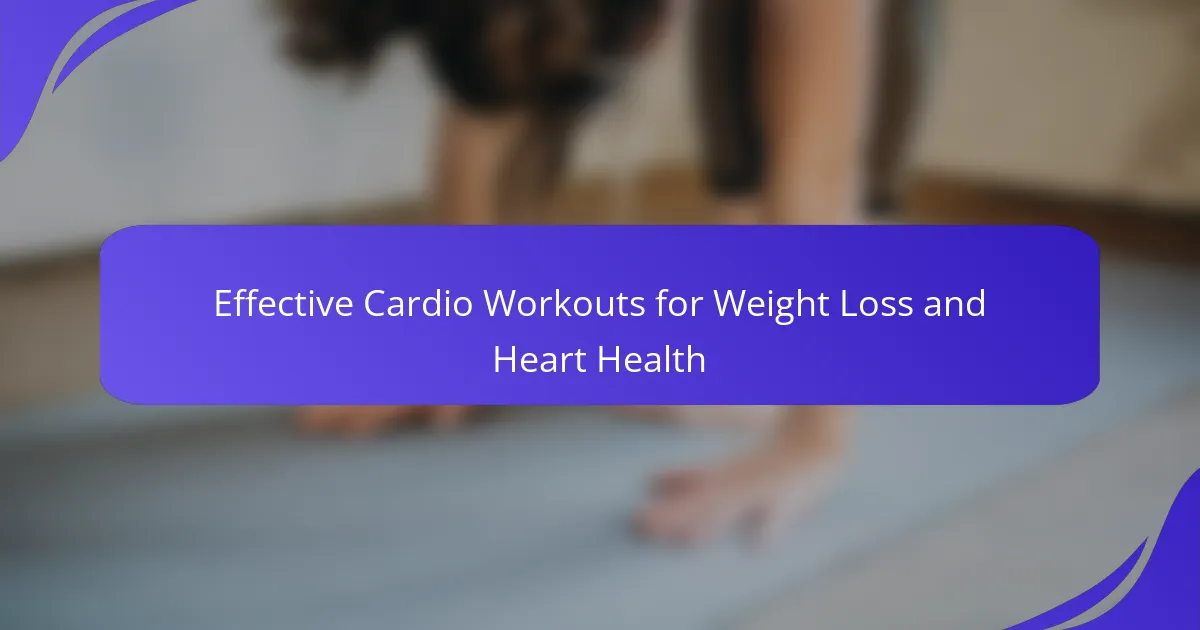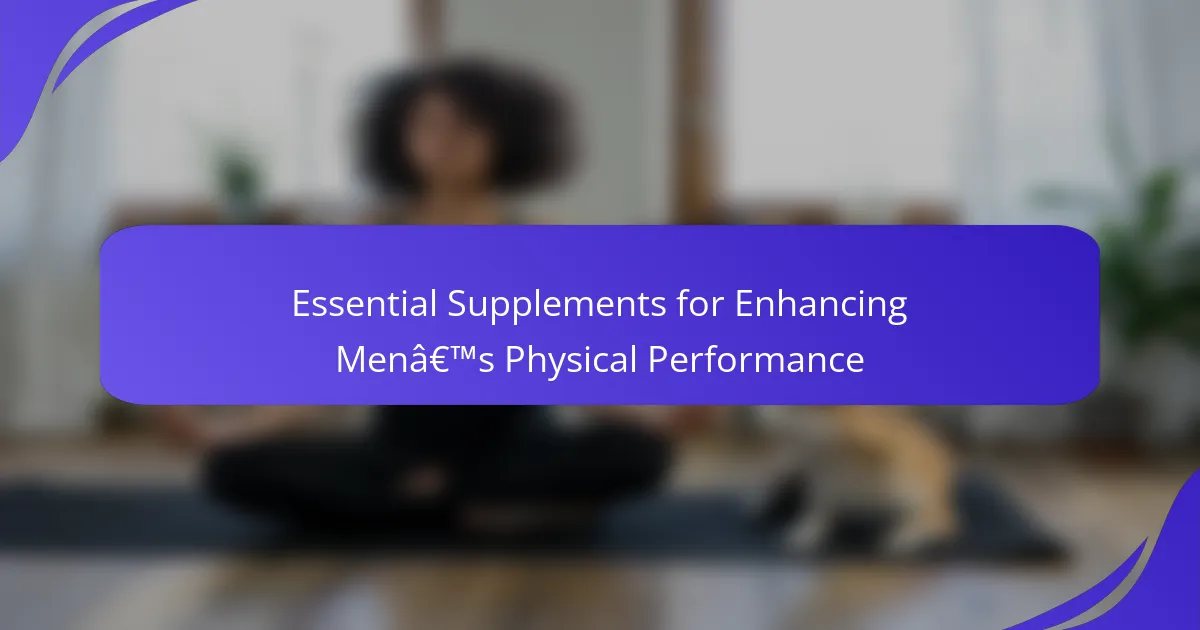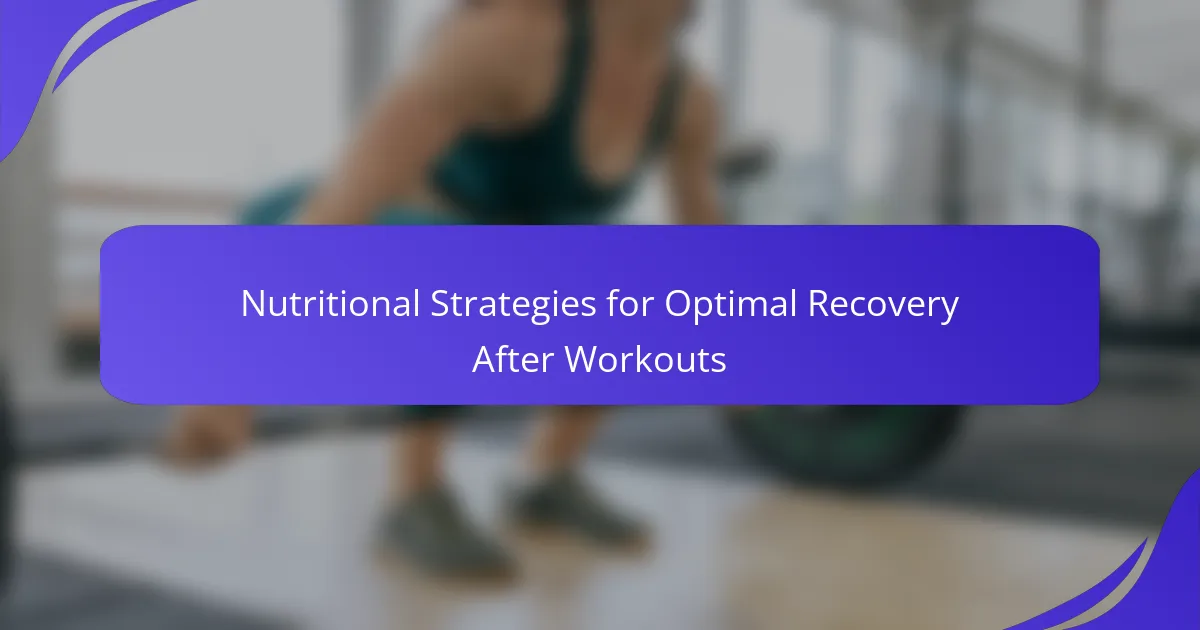High-Intensity Interval Training (HIIT) can significantly enhance men’s fitness by improving cardiovascular health, increasing metabolism, and building muscle strength. This efficient workout method allows for greater calorie burn in less time, making it ideal for busy schedules. HIIT also boosts testosterone levels and promotes muscle preservation during weight loss, while its adaptability caters to various fitness levels and preferences. Understanding these benefits can help men optimize their fitness routines effectively.

What are the core benefits of High-Intensity Interval Training for men’s fitness?
High-Intensity Interval Training (HIIT) offers numerous benefits for men’s fitness, including improved cardiovascular health, increased metabolism, and enhanced muscle strength. HIIT workouts can burn more calories in a shorter time compared to traditional exercise, making them efficient for weight loss.
The unique attribute of HIIT is its ability to elevate the heart rate rapidly, leading to greater cardiovascular endurance. As a result, men can enjoy benefits like improved stamina and reduced risk of heart disease. Additionally, HIIT can enhance insulin sensitivity, which is crucial for metabolic health.
Research shows that men participating in HIIT can achieve significant gains in muscle mass and strength, particularly in the lower body. This is due to the high-intensity nature of the workouts, which stimulates muscle growth and fat loss simultaneously.
Finally, HIIT is versatile and can be tailored to individual fitness levels and preferences, allowing for a wide variety of exercises such as sprinting, cycling, or bodyweight movements. This adaptability makes it a rare and appealing option for many men seeking to improve their fitness.
How does HIIT improve cardiovascular health?
High-Intensity Interval Training (HIIT) significantly enhances cardiovascular health by improving heart efficiency and increasing aerobic capacity. Studies show that HIIT can lead to a 15% increase in VO2 max, which measures the body’s ability to utilize oxygen during exercise. This training method promotes better blood circulation and lowers resting heart rate, reducing the risk of heart disease. Additionally, HIIT can improve metabolic health by aiding in weight management, which is crucial for cardiovascular well-being.
What role does HIIT play in weight management?
High-Intensity Interval Training (HIIT) significantly aids in weight management by boosting metabolism and promoting fat loss. This training method increases calorie burn during and after workouts, enhancing overall energy expenditure. Studies indicate that HIIT can lead to a greater reduction in body fat compared to steady-state cardio. Additionally, HIIT preserves lean muscle mass, which is crucial for maintaining a healthy metabolic rate. The unique attribute of HIIT is its efficiency, allowing for effective workouts in shorter timeframes, making it ideal for busy individuals.
How can HIIT enhance muscle strength and endurance?
High-Intensity Interval Training (HIIT) significantly enhances muscle strength and endurance through its intense, varied workouts. This training method combines short bursts of high-intensity exercise with recovery periods, promoting muscle hypertrophy and improving cardiovascular efficiency.
Research indicates that HIIT can lead to greater muscle gains compared to traditional steady-state cardio. For instance, a study showed that individuals performing HIIT experienced a 20% increase in muscle strength over eight weeks. Additionally, HIIT improves endurance by increasing the body’s ability to utilize oxygen efficiently during physical activity.
The unique attribute of HIIT is its time efficiency, allowing individuals to achieve substantial fitness improvements in shorter durations. This makes it particularly appealing for those with busy schedules. As a result, HIIT serves as an effective strategy for men aiming to boost both muscle strength and endurance concurrently.

What unique advantages does HIIT offer for men’s fitness?
High-Intensity Interval Training (HIIT) offers unique advantages for men’s fitness, including improved cardiovascular health, enhanced fat loss, and increased metabolic rate. HIIT workouts can be completed in shorter timeframes, making them efficient for busy schedules. The intensity of HIIT also promotes muscle preservation while losing weight, which is often a challenge in traditional cardio. Additionally, HIIT can boost testosterone levels, contributing to better strength and overall fitness. These benefits make HIIT a powerful tool for men aiming to optimize their fitness routines.
How does HIIT save time compared to traditional workouts?
High-Intensity Interval Training (HIIT) saves time compared to traditional workouts by offering efficient, intense bursts of exercise followed by short recovery periods. This structure allows for a complete workout in 20-30 minutes, significantly less than the typical 60 minutes required for traditional training. HIIT can boost metabolism and enhance cardiovascular fitness in a shorter duration, making it ideal for busy schedules. Studies show that individuals can achieve similar or even superior fitness results with HIIT compared to longer, moderate-intensity sessions. This efficiency is a unique attribute that appeals particularly to men seeking effective fitness solutions.
What psychological benefits are associated with HIIT?
High-Intensity Interval Training (HIIT) offers significant psychological benefits, including improved mood, reduced stress, and enhanced cognitive function. Engaging in HIIT can lead to the release of endorphins, which promote feelings of happiness and satisfaction. Additionally, the structure of HIIT workouts can foster a sense of accomplishment and motivation. Research indicates that participants often experience lower anxiety levels and increased self-esteem after consistent HIIT sessions. These psychological advantages contribute to overall mental well-being, making HIIT a valuable component of men’s fitness routines.

What rare attributes make HIIT stand out?
High-Intensity Interval Training (HIIT) stands out due to its unique ability to enhance metabolic rate post-exercise. This phenomenon, known as excess post-exercise oxygen consumption (EPOC), allows for increased calorie burning long after workouts. Another rare attribute is its adaptability; HIIT can be customized for various fitness levels and goals, making it accessible and effective for men of all ages. Additionally, HIIT significantly improves cardiovascular health, providing benefits comparable to longer, moderate-intensity workouts in a fraction of the time.
How does HIIT influence metabolic rate post-exercise?
High-Intensity Interval Training (HIIT) significantly boosts metabolic rate post-exercise. This effect, known as excess post-exercise oxygen consumption (EPOC), can elevate calorie burn for hours after workouts. Research indicates that HIIT can increase metabolic rate by 6-15% following sessions, leading to enhanced fat loss. Additionally, the intensity of HIIT workouts promotes muscle preservation, further contributing to a higher resting metabolic rate.
What are the specific adaptations in hormone levels due to HIIT?
High-Intensity Interval Training (HIIT) leads to specific adaptations in hormone levels, including increased testosterone and growth hormone. These changes enhance muscle growth, fat loss, and overall fitness. Research indicates that HIIT can elevate testosterone levels by up to 20% post-exercise, promoting better recovery and strength gains. Additionally, growth hormone levels can surge significantly during HIIT sessions, contributing to improved metabolic function and fat oxidation. These hormonal adaptations are key benefits of HIIT, making it an effective training method for men’s fitness.

How can regional preferences affect HIIT training methods?
Regional preferences can significantly influence HIIT training methods by tailoring workouts to cultural norms and fitness trends. For instance, in regions with a strong emphasis on community, group HIIT classes may be more popular, enhancing motivation and adherence. Alternatively, areas that prioritize individual fitness may favor personalized HIIT routines, focusing on specific goals and performance metrics. Additionally, climate can affect training styles; warmer regions might incorporate outdoor HIIT sessions, while colder areas may rely on indoor facilities. Understanding these regional preferences allows fitness professionals to design effective and engaging HIIT programs that resonate with local populations.
What variations of HIIT are popular in different regions?
High-Intensity Interval Training (HIIT) has various popular variations across different regions, each tailored to local fitness cultures. In the United States, Tabata and circuit training dominate, emphasizing short bursts of intense exercise. In Europe, particularly Scandinavia, outdoor HIIT sessions are common, integrating natural landscapes into workouts. In Asia, especially Japan, there is a focus on bodyweight HIIT routines, which are accessible and require minimal equipment. Australia favors beach-based HIIT classes, utilizing the coastal environment for dynamic workouts. Each variation highlights unique attributes, such as accessibility, environment, and equipment requirements, enhancing men’s fitness in diverse ways.
How do cultural attitudes shape HIIT participation among men?
Cultural attitudes significantly influence men’s participation in High-Intensity Interval Training (HIIT). Societal norms often shape perceptions of fitness and masculinity, leading men to seek intense, time-efficient workouts.
Research shows that cultures valuing physical strength and competitiveness encourage HIIT participation. Men often associate HIIT with improved performance, body image, and social status. Additionally, communities that promote fitness as a lifestyle tend to see higher engagement in HIIT programs.
Unique attributes like social support and competition can further enhance motivation. Men in supportive environments are more likely to embrace HIIT, while those in competitive cultures may push themselves harder.
Overall, cultural context plays a crucial role in shaping fitness choices, with HIIT appealing to men seeking effective results within a supportive or competitive framework.

What are the best practices for incorporating HIIT into a fitness routine?
To effectively incorporate High-Intensity Interval Training (HIIT) into a fitness routine, focus on structured sessions. Start with 20-30 minutes of HIIT, 2-3 times per week. Gradually increase intensity and duration to enhance cardiovascular fitness. Include a warm-up and cool-down to prevent injury. Track progress to stay motivated.
What common mistakes should men avoid when starting HIIT?
Men should avoid overtraining, neglecting proper form, skipping warm-ups, and ignoring recovery. These mistakes can lead to injuries and hinder progress. Incorporating adequate rest and focusing on technique enhances the effectiveness of high-intensity interval training, maximizing its benefits for fitness.
How can men optimize their HIIT workouts for maximum benefits?
Men can optimize their HIIT workouts by focusing on intensity, recovery, and nutrition. Prioritize short bursts of maximum effort followed by adequate rest to enhance performance. Incorporate compound movements like squats and push-ups for full-body engagement.
Tracking progress is essential; aim for incremental improvements in speed or repetitions. Nutrition plays a critical role; consuming protein post-workout aids muscle recovery. Hydration before, during, and after workouts maximizes performance and recovery.
Consider varying workout routines to prevent plateaus and maintain motivation. Engage in cross-training to improve overall fitness and reduce injury risk. Emphasizing these strategies will lead to significant fitness gains.



